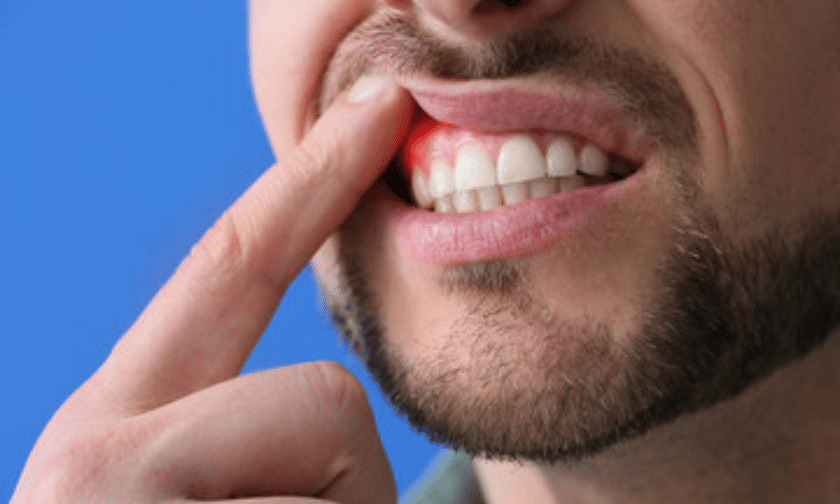If you have swollen, red, tender, or receding gums, you may be suffering from gum disease. If left untreated, the bacteria will grow in your mouth and cause tooth loss or destruction of the tissue that surrounds your teeth. Following is a complete guide to gum disease, i.e., the stages, prevention, and treatment.
The Five Stages Of Gum Disease
There are five stages of gum disease. Gingivitis is the earliest stage of gum disease. It then moves from slight periodontal disease to moderate periodontal disease, to severe stage of periodontitis and ultimately advanced periodontal disease.
1. Gingivitis
Gingivitis is the easiest to treat and doesn’t cause much harm to your gums. It only affects the gingiva, i.e., the party that surrounds the base of the teeth. At this stage, your gum will bleed.
Gingivitis symptoms are easy to ignore as it is usually painless. Very often people assume their gums are bleeding because of brushing too hard. However, bleeding gums are a warning sign and should not be ignored.
Gingivitis is the only stage that can be reversed. If you maintain good oral hygiene, visit the dentist for regular check-ups, and cleanings, it will prevent gingivitis from progressing further. Your periodontist can help you with your gum disease treatment in Reno, NV, which will ensure you have completely healthy gums.
2. Slight Periodontal Disease
In the early stage of gingivitis, gum inflammation can occur within five days. If you don’t treat the signs of generalized gingivitis, it will become more noticeable. You still won’t face pain or any other symptoms at this stage, but there will still be bleeding, and your gums will be more inflamed. Once gum disease reaches this stage, it cannot be reversed, but it can be managed with the help of a periodontist and dental team in Reno, NV
3. Moderate Periodontal Disease
At this stage, your gums will start to recede and create tiny pockets between your teeth and affected gums. This can cause plaque of harmful bacteria to invade these spaces causing more bleeding. In the initial stages, there is minimal damage, and it is almost undetectable. Moderate periodontitis is more obvious as there is more damage, which is also permanent.
4. Severe Stage Of Periodontitis
In the severe stage of periodontitis, as more tissues die, your teeth will get loose. The surrounding teeth and the bone will start to deteriorate. Here you have the very real possibility of losing teeth.
If your gum disease has reached this stage, you still might not experience pain. However, there are a few symptoms that you might notice. A few are as follows:
- Bad breath
- Bad taste
- Receding gums
- Loose or moving teeth
- Change in the bite or soreness
- Swellings or abscess
In this stage, the only option for treatment is surgery with a mix of other options, based on the extent of damage/
5. Advanced Periodontal Disease
This is the worst stage of gum disease. It can cause irreversible damage to your overall health. It can also cause damage to the connected bones, and you can even lose all your teeth. There will be significant drifting and splaying of the front teeth, with gaps forming in between. It is absolutely necessary to get treatment at this stage.
Advanced periodontal disease can lead to several serious health problems such as diabetes or a heart attack. This cannot be reversed, but it can be managed with the help of the periodontist in Reno, NV, and other qualified professionals who will stabilize the disease.
How To Prevent Gum Disease?
1. Brush And Floss
Brush twice daily and floss once every day to ensure there’s no plaque build-up or food stuck between your teeth. You should use a toothbrush with soft bristles and replace the brush after every few weeks
2. Use Fluoride Toothpaste & Mouthwash
To make sure gingivitis doesn’t progress, use a good toothpaste that contains fluoride in it to ensure proper cleaning. You can even use a mouthwash to prevent or reduce gingivitis and slow down plaque and tartar build-up. It removes food particles stuck in your teeth and eliminates debris from your mouth.
3. Get Regular Dental Cleanings & Checkups
The symptoms or signs of gum disease are often undetectable until the situation gets worse. Therefore, you need to visit a good periodontist in Reno who is qualified to diagnose and treat your gum disease. You should visit the dentist regularly once every six months for a dental checkup to ensure there are no hidden dental issues. If you have gingivitis brushing, flossing, and dental cleanings will help to treat your gum disease.
4. Quit Smoking
If you smoke, you are most likely susceptible to get gum disease. Smoking can make your immune system weak, which makes it difficult to fight bacteria and infections.
What Are The Treatments For Gum Disease?
The best way to get rid of the gum disease is to go to your dentist who examines the extent of the damage and provides you with the appropriate treatment option.
1. Deep Cleaning
You can get a proper deep cleaning to remove all the plaque and tartar build-up accumulated in tough-to-reach spots. This will treat gingivitis and slight periodontal disease and ensure healthy gums.
2. Laser Gum Surgery
Lasers are tubes that use light beams of thermal energy to perform multiple tasks during gum surgery. A few are as follows:
- Remove diseased tissue
- Coagulate blood vessels and form solid clots
- Eliminate germs and bacteria
- Sterilize the affected area
Gum Disease Treatment In Reno, NV
If you are suffering from tender, swollen, or receding gums, visit our dental office immediately to ensure safe and healthy gums. Our experts at The Reno Dentist will make sure you get the required care to treat your issues effectively. Contact us today to know more about periodontitis or schedule your free appointment with the best periodontist in Reno, NV.


